Andean Spanish
1. Introduction
For much of the colonial period, the central Andean region was split between the Audiencia districts of Quito, Lima and Charcas, the latter having its capital at Sucre (formerly La Plata) in Bolivia. Although Lima is situated on the Pacific coast, Sucre and (to a lesser extent) Quito are Andean cities. Other important Andean cities include Potosí (Bolivia), which at one time had a larger population than London, and Cuzco (Peru), originally the capital of the Inca Empire and subsequently a significant provincial Spanish town in the southern Peruvian Andes.
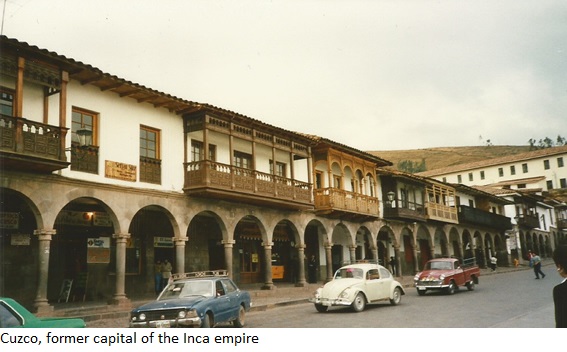
Language contact between Spanish and indigenous Andean languages (Quechua throughout the region and Aymara in southern Peru and Bolivia) has been long-lasting and intense. In many areas stable forms of interlanguage Spanish have been in use for centuries and it is likely that the speech of some monolingual speakers – especially in the remoter urban centres, such as Puno or Juliaca in southern Peru – represents a crystallization of such hybrid systems. The term ‘Andean Spanish’ is commonly applied to the spectrum of speech types, from interlanguage to indigenously-influenced monolingual Spanish, that are encountered in the highland area stretching from the equator to the Tropic of Capricorn, as shown in the map below.
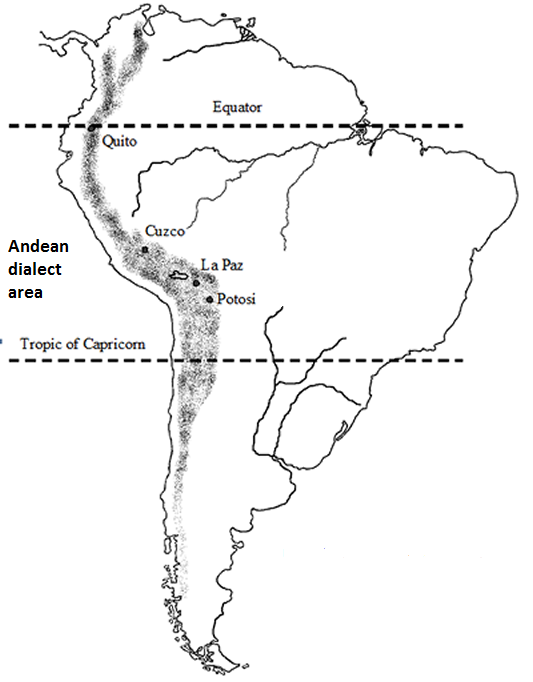
2. Pronunciation
2.1 Pronunciation of /s/
In general, syllable-final /s/ undergoes none of the ‘weakening’ or assimilatory processes that are typical of southern Spain, the Canaries and coastal Latin America. On the other hand, highland Ecuadorian Spanish exhibits routine voicing of word-final /s/ before a vowel, as in [lozaˈmiɣos] los amigos ‘the friends’, a tendency that runs counter to the historic loss of voiced sibilants in Spanish which began in the 16th century.
2.2 Retention of the /ʝ/ ~ /ʎ/ distinction
Throughout most of the Andes, a phonemic distinction is maintained that corresponds to the distinction drawn in the spelling between the letter y and the digraph ll. In Peru and Bolivia, this distinction replicates the Castilian distinction between the voiced palatal fricative /ʝ/ and the palatal lateral /ʎ/, while in Ecuador it takes the form of /ʝ/ versus the voiced palato-alveolar fricative /ʒ/. The distinction (in both its manifesations) can be seen in contrasts such as the following:
[ˈʝema] yema ‘yolk’ versus:
[ˈʎame] (Peru, Bolivia) or [ˈʒame] (Ecuador) llame ‘call!’
[ˈoʝe] oye ‘hears’ versus:
[ˈoʎa] (Peru, Bolivia) or [ˈoʒa] (Ecuador) olla ‘pot’
This preservation of a distinction that has been eliminated in most other parts of the Spanish-speaking world seems likely to be due to substrate influence, given that a contrast between /ʝ/ ~ /ʎ/ exists in both Aymara and Quechua. Compare, for example, Aymara [ˈʝapu] yapu‘field’ and [ˈʎapa] llapa ‘flat’, [ˈxaʝa] jaya ‘far’ and [ˈxaʎu] jallu ‘rain’.
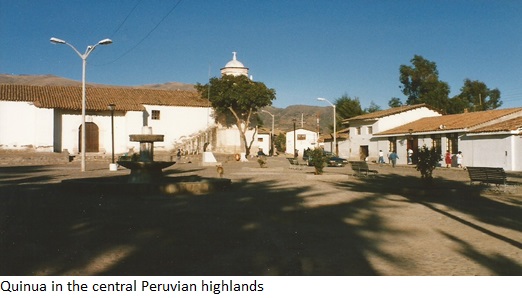
2.3 Assibilation of /ɾ/ and /r/
Strongly assibilated variants of [ɾ] and [r] are frequent in the Spanish of the region. Some examples are as follows:
[ˈʐoto] roto ‘broken’
[tʂaβaˈxamos] trabajamos ‘we work’
[ˈpʂaktikaˈmente] prácticamente ‘practically’
The assibilated r (Spanish: erre asibilada) is actually a variable that is found in many parts of the Spanish-speaking world, so it would be unwise to claim that it represents an instance of substrate influence in the Andes. However, it is interesting to note that some varieties of Quechua have a retroflex affricate /tʂ/. For example, in the Cajamarca–Cañaris dialect, the word for ‘tail’ is ch'upa, pronounced [ˈtʂupə]. Conceivably this affricate may have contributed to the diffusion of the assibilated r in the post-/t/ context in Andean Spanish, which is illustrated by pronunciations such as [ˈkwatʂo] for cuatro ‘four’. Pronunciations such as the latter can give the impression that the relevant word is spelled with ch rather than tr.
2.4 Pronunciation of /f/
/f/ is commonly articulated as a voiceless bilabial fricative (symbol: [ɸ]): [ˈɸɾuta] fruta ‘fruit’. An epenthetic [w] is often inserted between [ɸ] and a following vowel: [ɸwaˈmilja] familia ‘family’.
2.5 Reduction of unstressed vowels
Unstressed vowels are routinely weakened to a schwa-like sound [ə] or even elided completely, particularly when next to /s/. An example of reduction to [ə] would be [ˈesəsˈtʃikəs] esos chicos ‘those kids’, while both reduction and elision are illustrated in [ˈtoðəsˈessluˈɣaɾes] todos esos lugares ‘all those places’. Vowel reduction/elision, combined with the usual retention of syllable-final /s/, results in Andean Spanish producing a strikingly different auditory impression from Caribbean and Pacific coast Spanish.
2.6 Loss of vowel phonemes
In heavily Quechua- or Aymara-influenced dialects, the three-way height contrast (low ~ mid ~ high) of mainstream Spanish may be replaced by a binary opposition. Thus while standard Spanish exhibits five vowel phonemes, /a, e, i, o, u/, some Andean speakers may have just three, which conventionally are represented as /a, i, u/. The front and back phonemes /i/ and /u/ may be realized as high (e.g. [ˈmisa] mesa ‘table’ and [ˈʐutu] roto ‘broken’) or as mid (e.g. [ˈtʃekas] chicas ‘girls’ and [ˈɸɾota] fruta ‘fruit’) but no clear linguistic rule seems to condition either type of articulation, implying that the two are in free variation.
3. Terms of address
In the Ecuadorian and Bolivian Andes voseo is common, especially in rural areas or among economically marginalized speakers. In contrast, voseo is now all but extinct in the Peruvian Andes. Where voseo exists in the Andes, the choice of associated verb forms tends to be an ethnolinguistic marker, with speakers who identify with the Hispanic component of society preferring forms that are identical to those that go with tú in standard Spanish (cantas, comes, vives etc.) and speakers with a markedly indigenous background gravitating towards the system shown in the table below.
| -ar | -er | -ir | |
|---|---|---|---|
Present indicative |
cantás | comís ~ comés | vivís |
Present subjunctive |
cantís ~ cantés | comás | vivás |
Imperative |
cantá | comé | viví |
In the southern Bolivian Andes, extending into Chile and northwestern Argentina, it is common for speakers to have a system in which the forms corresponding to vos are identical to those that go with vosotros in standard Spanish, except in the imperative (where there is variation between root-stressed forms and ending-stressed forms without final /d/) and except where standard Spanish has -éis, which in the Andes is usually replaced by -ís.
4. Syntax
4.1 Discourse markers reanalysed as modal suffixes
Discourse markers such as pues ‘well’, nomás ‘just/it’s fine’ and pero ‘but’ are routinely used in Andean Spanish in ways that recall the modal suffixes of Quechua and Aymara, which are so called because they mark varying degrees of speaker commitment to or involvement in the action or event denoted by the verb. Like the Quechua and Aymara suffixes, the relevant Spanish discourse markers are typically stacked in clause-final position:
(1) Dile nomás pues pero.
‘Just go ahead and tell him.’
Compare Aymara Sakirakipunï:ta, which has an identical meaning to the above example. The Aymara structure is formed by agglutinating the suffixes ki, raki, puni and y (the last two being fused), plus the 2nd person singular marker ta, to the verbal root sa (from saña ‘to say’).
4.2 Double possessives
Another widespread feature is the use of ‘double possessives’, as in (2) below:
(2) De María en su casa estoy yiendo.
‘I’m going to María’s house.’
The sequence de María [. . .] su casa, in place of la casa de María appears to be modelled directly on a Quechua construction. The corresponding expression in Quechua is Mariyax wasin ‘María’s house’, in which the form Mariya corresponds to ‘María’, wasi means ‘house’ and -x and -n together indicate posession.
Example (2) also illustrates the common Andean use of the preposition en to indicate ‘motion towards’. Additional region-specific uses of en include the use of this preposition before a locative adverb, as in Vivo en acá ‘I live here’ or En allá sale agua ‘Water is coming out there’. This latter type of use may represent an analogical extension of the standard usage whereby en is prefixed to the relative adverb donde, as in La habitación en donde duermo es pequeña (from the Diccionario panhispánico de dudas of the Real Academia Española).
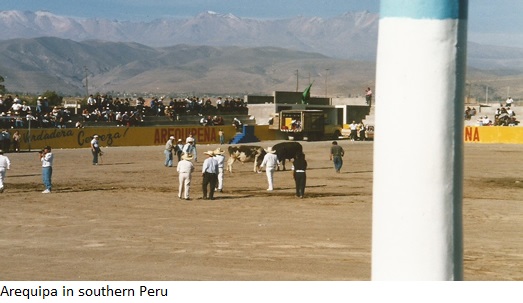
4.3 Data source marking
Certain varieties of Andean Spanish exhibit a system of data source marking that appears to reflect convergence with local indigenous languages, in particular Aymara. There are at least three grades of data source in Aymara: personal knowledge, knowledge through language, and non-personal knowledge (the examples that follow are from Hardman de Bautista 1982:152-153). Assertions based on personal knowledge are unmarked, in that only the assertoric affix w(a) is present, as in Mama Marsilaw t’ant’ manq’i ‘Ms. Marcela ate bread’, where the speaker has direct sensory experience of the event described. Knowledge through language is indicated through the use of siw, the 3rd person pres. tense of saña ‘to say’, as an independent particle, although again the assertoric affix w(a) may be present: Mama Marsilaw t’ant’ manq’i siw ‘Ms. Marcela ate bread (so I’m told)’. And the prototypical exponent of non-personal knowledge, in the 3rd person (plu. and sing.), is the verbal affix -tayna, as in Mama Marsilax t’ant’ manq’atayna ‘(Apparently) Ms. Marcela ate bread’. This category of data source also includes information that comes as a surprise to the speaker: Pitañ yatitayna ‘(So) they knew how to smoke!’. Comparable evidential distinctions are made also in Quechua, especially using the suffix -sqa.
This tripartite system of data source marking is replicated in interlanguage Spanish and also, as a consequence of linguistic transfer, in popular dialects of monolingual Andean Spanish through a redeployment of existing resources. More specifically, both the pluperfect tense (había hecho) and the verb form dice ‘he/she says’, the latter recycled as a generally clause-final particle, come to have an evidential or data source-indicating meaning. The following examples of pluperfect usage are from an article about graffiti in a public lavatory that appeared in the Cuzco weekly review El Tiempo (18th to 24th September 1994):
(3) El jefe había tenido pelos en su sentadera.
(4) El Justo Condorhuamán había sido hijo de Pablo Muchotrigo.
Like the exponents of non-personal knowledge in Aymara and Quechua, the Spanish pluperfect in the varieties in question is also used to express surprise, a feature of usage that seems to have seeped into the monolingual speech of even educated Limeños:
(5) ¡Ahhh! ¡Vivo habías sido!
(6) ¡Habían sabido fumar!
Evidential dice, which is frequent in the interlanguage, has perhaps a greater currency in monolingual Andean Spanish than the evidential pluperfect. This presumably is due to the fact that the dice phenomenon represents a smaller departure from mainstream Spanish. Hardman de Bautista (1982:154) gives the following examples:
(7) Marcela está enferma dice.
(8) Estaba enojada dice.
A variant form of this construction, involving the complementizer que, arises when dice occurs clause-internally:
(9) Shumaya dice que comió pan.
Note that the impersonal meaning of dice is retained in this type of case, so that Shumaya must be interpreted as the subject of comió and not of dice.
4.4 The dar + gerund construction
In highland Ecuador at least, the use of dar ‘to give’ + gerund is common. This is a construction which may well be modelled on a similar structure in Quechua. Two examples are given below:
(10) Dame cerrando la puerta.
‘Open the door for me’
(11) Pedro dio componiendo mi reloj.
‘Pedro fixed my watch.’
5. Lexicon
Andean Spanish is defined above all in syntactic and phonological terms. Moreover, as a consequence of Peru’s central position in the colonial effort, many of the Quechua loanwords in Spanish have a general currency throughout Latin America. Accordingly, there are not that many lexical items that could be described as typically Andean. Of those that can be, the following are derived from Quechua: anticucho ‘kebab’, cancha ‘toasted maize’, chacra ‘small farm’, choclo ‘corn on the cob’, concho ‘sediment/left-overs’, chuño ‘potato flower’, opa ‘foolish/clumsy’, soroche ‘altitude sickness’, amarcar ‘to cradle in one’s arms’, chulla ‘odd [of sock]/single’, acullico (small ball of coca leaves), oca (root vegetable), quinua (high-altitude cereal plant), guagua ‘baby’, me/te etc. tinca que ... ‘I/you etc. get the feeling that ...’, yanacón ‘tenant farmer’.
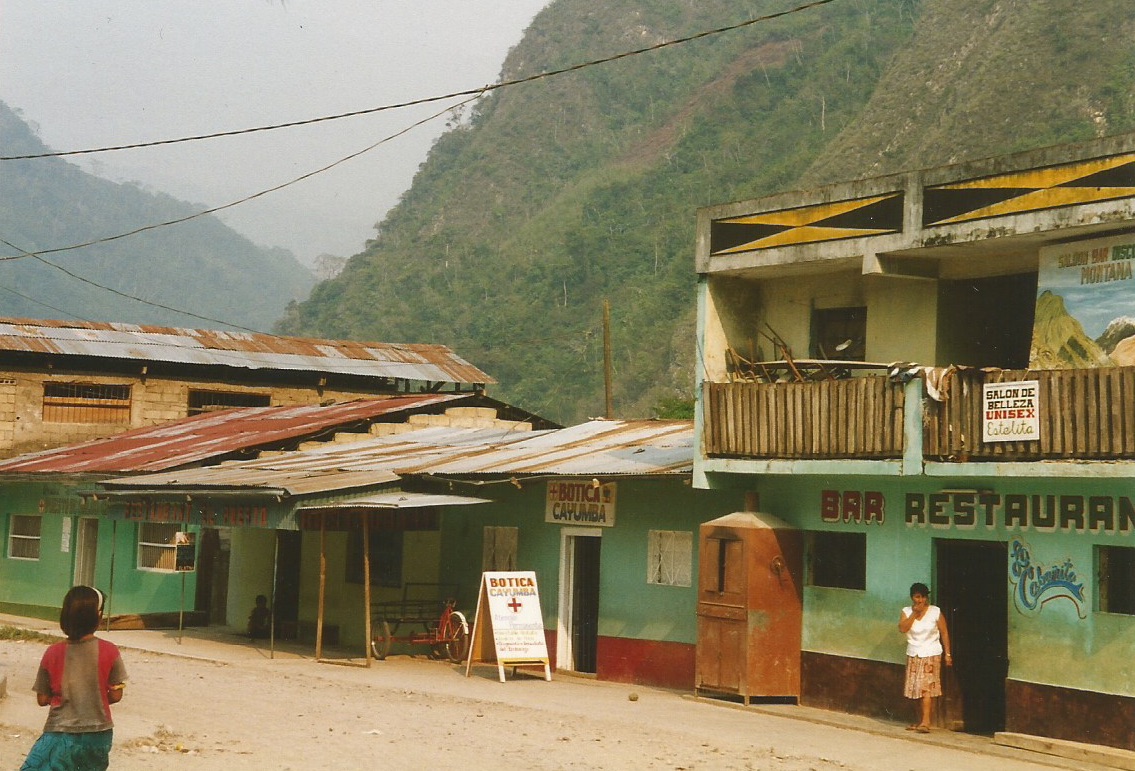
Ayamara appears to have provided a relatively small number of loanwords, three of which are aguayo (multicoloured cloth; mainly used in Bolivia), yapa ‘small amount given in addition’ and challar ‘to bless with alcohol’.
In addition to lexical borrowing, Andean Spanish reflects shifts in the meaning of common Peninsular words. For example, while in Peninsular Spanish, pie refers only to the foot, from the ankle down, in Andean Spanish, it may refer to the limb from the knee down or to the entire leg, thus reflecting the semantic field of Aymara kayu. Andean Spanish pie is in fact closer in meaning to Peninsular pierna. The adverb siempre has also changed its meanings, from ‘always’ to ‘still’. Thus Siempre está aquí means ‘He/She is still here’ rather than ‘He/She is always here’, which is what the sentence would mean in Peninsular Spanish.
6. References
Hardman de Bautista, Martha. 1982. ‘The mutual influence of Spanish and the Andean Languages.’ Word 33:143-57.